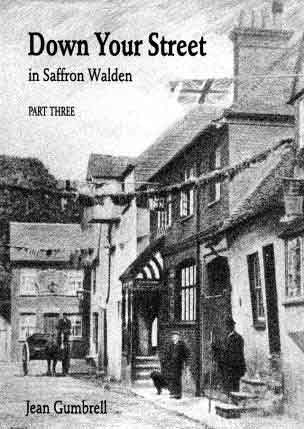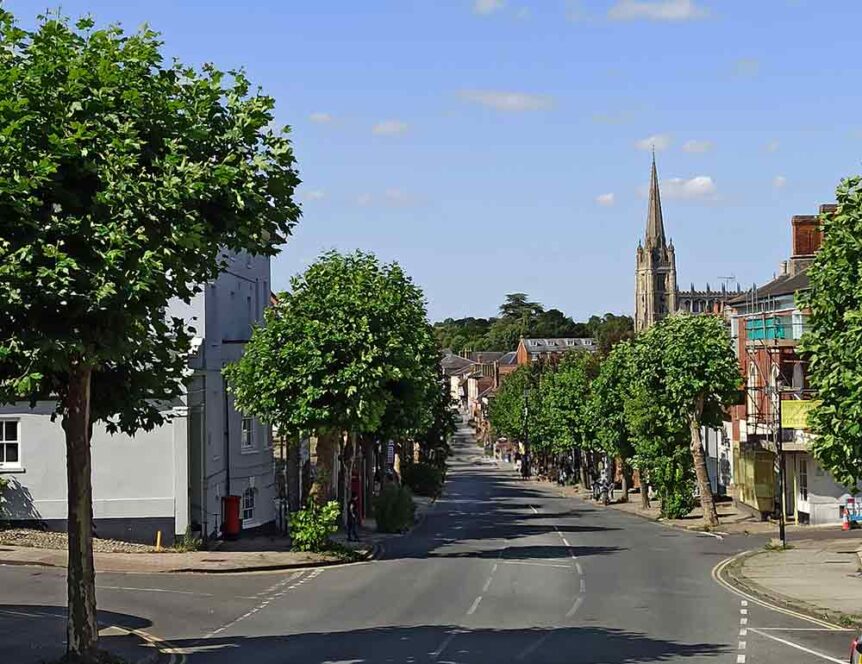© Jean Gumbrell
Reprinted from Saffron Walden Historical Journal No 18 Autumn 2009
The featured image above is of Saffron Walden High Street. © Saffron Walden Historical Society

I had been writing features for the Weekly News for almost four years when the Editor, the late Gordon Richards, asked me if I would be interested in a new series called Down Your Street. It had been extremely successful in the Cambridge Evening News and he thought that a similar series featuring Saffron Walden would be just as successful. I jumped at the opportunity. Then I came down to earth – I was no historian! Would the quality of my writing be good enough? Could I sustain what I had set out to do? ‘Once you start a street’, Gordon warned, ‘you must go on right to the end. I don’t want any breaks in a street. If you want a bit of a rest when you’ve completed one street, that’s alright but – no breaks in between!’
There were other problems. I was an incomer who didn’t even live in the town and had only been in the area 16 years. I had no contacts to speak of. So where and how should I start? Di Pohlmann, reporter in charge at the Weekly News office suggested the High Street. Why? ‘Because it’s one of the most historic streets in the town and one of the longest and if you can crack the High Street, you can crack any street that comes your way!’ Di was helpful. ‘Use the rating lists, you’ll find them in the Library, ask the librarians, contact Mr Stacey – he knows so much about the town, then there’s the Museum…’
From the very outset, John Shaw-Ridler and his team at the Library were more than co-operative. Perhaps by this time I had discovered the Town Library. I’m not sure, but certainly I was completely unaware of all the wonderful historical treasures it held, especially the old town Almanacs. To this day I still feel Harts’ Almanacs are the richest source of social history available. I don’t know which librarian it was who introduced me to THE THESIS, but Mrs Monteith’s thesis certainly became my bible! Then Mary Whiteman – bless her – suggested I contact Mr Lovatt who had painstakingly copied out many of the old rating lists. Mr Lovatt generously lent me copies as and when I needed them. I found the lists invaluable when trying to trace certain buildings. By pinpointing, say, a pub or other notable building, I could count backwards or forwards to locate a particular house. (The numbers of houses change quite frequently over the years – large houses made into two or three smaller ones, small houses incorporated into large ones or, demolished and of course infilling!)
The 1851 Census also became popular reading for me until I dropped it on my foot (it wasn’t on microfiche in those days). Then of course there was Saffron Walden Then and Now, the Antiquarian Society journals, the Department of Environment Notes on Listed Buildings and hosts of pamphlets and leaflets, too many to name. If it wasn’t in the library, I would go up to the Museum and either Len Pole or Maureen Evans would be sure to point me in the right direction. Mr Stacey (former Town Clerk) was also most co-operative.
But the most wonderful thing of all, once Down Your Street got underway, everyone joined in. I got the most marvellous co-operation from everyone because – I think – everyone regarded the series as theirs. And I learnt so much. Not just about Saffron Walden itself, but about people, the way they lived, their houses and their way of life. I also learnt who and what to avoid. First and foremost – leave churches alone! Every church has its archivist. It’s their church and they don’t like other people interfering. This is not to say that some church historians and archivists were not extremely helpful, because they were. Secondly, beware the colourful local character! Colourful he or she may be! Colourful local characters tend to be extremely self-absorbed and love the sound of their own voices. They will hint of stories that would make your hair curl – but they won’t tell you – or, if willing to share, the anecdotes are so libelous that no editor in his right mind would print them. On the other hand the most surprising people can come up with the most interesting stories. An ex- schoolteacher gave me a wonderful account of her childhood spent in Radwinter. An elderly lady living in Castle Street told of her early years as a bride in that cottage, long before it was modernised. Retired shop assistants and office girls gave graphic accounts of just what it was like ‘in the old days’.
From February 1984 to June 1991, I walked the streets and delved into the history of Saffron Walden and its people and I loved every minute of it. It was extremely hard work – at times it seemed as if every day of my life was committed. Gordon had warned that he was putting me on a treadmill, and it certainly was! But it was a truly wonderful experience and something I wouldn’t have missed for worlds – right up my street!
Note: The original articles, on which the books published from 1984 to 1996 were based, can be found in Saffron Walden Town Library.

